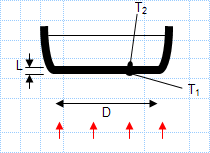Heat transfer in a pan.xls

Description
KNOWN: Thickness, diameter and inner surface temperature of bottom of pan used to boil water. Rate of heat transfer to pan.
FIND: Outer surface temperature of pan for an aluminium and a copper bottom.
ASSUMPTIONS: One-dimensional, steady state conduction through bottom of pan.
Calculation Reference
Fundamentals of Heat and Mass Transfer - Frank P. Incropera
To calculate the outer surface temperature of a pan with an aluminum or copper bottom, considering the known thickness, diameter, inner surface temperature, and rate of heat transfer to the pan, and assuming one-dimensional, steady-state conduction through the bottom of the pan, you can follow these steps:
-
Determine the thermal conductivity: Obtain the thermal conductivity (k) values for aluminum and copper. The thermal conductivity is a material property specific to each metal.
-
Calculate the heat flux: The heat flux (q') is the rate of heat transfer per unit area through the bottom of the pan and can be calculated using the given rate of heat transfer to the pan and the surface area of the bottom. The formula is:
q' = Rate of heat transfer / Bottom surface area
-
Calculate the temperature gradient: The temperature gradient (dT/dx) through the bottom of the pan can be determined using Fourier's Law of heat conduction:
dT/dx = q' / k
Where dT/dx is the temperature gradient, q' is the heat flux, and k is the thermal conductivity of the bottom material.
-
Calculate the outer surface temperature: The outer surface temperature (T_outer) of the pan can be found by subtracting the temperature drop across the bottom of the pan from the inner surface temperature:
T_outer = T_inner - (dT/dx * Thickness)
Where T_inner is the known inner surface temperature of the pan and Thickness is the thickness of the bottom of the pan.
By following these steps, you can calculate the outer surface temperature of a pan with an aluminum or copper bottom, based on the known parameters and assumptions. The assumption of one-dimensional, steady-state conduction through the bottom of the pan allows for simplified analysis.
Calculation Preview
Full download access to any calculation is available to users with a paid or awarded subscription (XLC Pro).
Subscriptions are free to contributors to the site, alternatively they can be purchased.
Click here for information on subscriptions.

